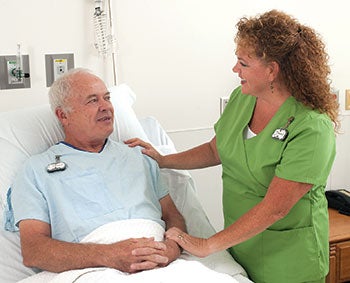Hospital installs alert system and reduces severity of staff injuries
 |
| A nurse wears a personal alert badge with which she summons help from security or other staff when situations turn less friendly. |
When John Dougherty took over duties as the director of security at Trinitas Regional Medical Center, Elizabeth, N.J., he became aware that some staff were particularly vulnerable to workplace violence.
They worked in more isolated areas of the 500-plus-bed hospital and with behavioral health patients who sometimes acted in a threatening or violent manner.
Nurses who worked in the medical center’s emergency department also were at risk of being victims of violence. The problem led to injuries and time off from work.
Of course, these conditions are not unique to Trinitas. The Bureau of Labor Statistics data show that for health care workers, assaults comprise about 11 percent of workplace injuries involving days away from work, as compared with 3 percent of injuries of all private sector employees.
A 2011 survey by the Emergency Nurses Association shows that 55 percent of emergency nurses reported experiencing physical violence or verbal abuse, with patients committing 98 percent of the acts.
In researching a solution to the safety challenge, Dougherty turned to Versus Technology Inc., Traverse City, Mich., and implemented a less common use of the company’s real-time locating system (RTLS).
The Visibility Staff Assist system enabled Trinitas to meet a requirement of the Joint Commission, Oak Brook Terrace, Ill., to help establish a safe workplace for staff and patients. It also meets an Occupational Safety and Health Administration recommendation that hospitals install a system for staff that enables them to contact security or other staff for help.
The Versus system does that by allowing staff who wear a personal badge to simply push a button to summon help to the victim’s precise location.
The technology also provides reports on all panic calls placed, so facilities can evaluate high-volume call areas and target education or security measures to offset threats. If the facility chooses, the badge button can instead be used as a request for nonemergency  assistance.
assistance.
Trinitas first implemented the system in its emergency department (ED) in 2013 and has expanded its use to its inpatient and outpatient psychiatric units and medical-surgical unit. More than 300 physicians, nurses and technicians wear the personal alert badges.
Staff feel safer knowing they can receive immediate assistance if necessary. “It helps morale in the ED, knowing that help is just a push button away,” says Denise Loneker, R.N., nurse manager in Trinitas’ ED.
Trinitas also determined that the system has produced a financial return on investment by analyzing data involving assaults on employees by combative patients, and the subsequent number of days lost from work due to injury.
Comparing the data for the year prior to installing the system to the 12-month period afterward, Trinitas found that assaults increased by nine incidents. But there were 101 fewer days of lost work because injuries were less severe due to quicker response to calls for help by staff who used the alert badge, Dougherty says. It also cut the cost of wages.
Despite the financial benefits, Dougherty says installing the system was about improving safety. “This is about providing peace of mind to our staff,” he says.
The system’s apparent impact on safety so impressed the Joint Commission that it asked Dougherty to write a best-practices report.
In his paper, titled “Workforce Violence in Healthcare Not Always Preventable: A Plan for Mitigation,” Dougherty concluded that workplace violence cannot be prevented, but it can be mitigated through technology and violence prevention training.
Compliance challenge
HOSPITAL // Trinitas Regional Medical Center
NEED // Meet Joint Commission staff and patient safety requirements
SOLUTION // Versus Technology Inc. Visibility Staff Assist system




